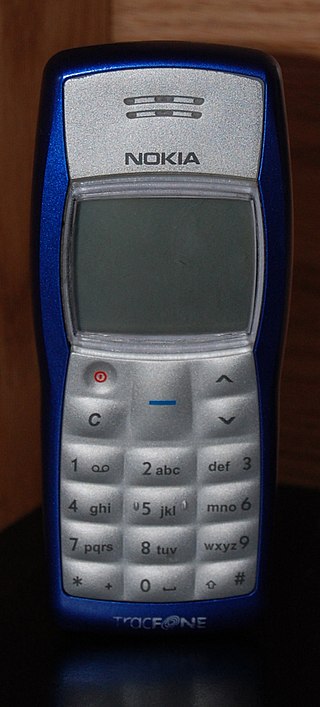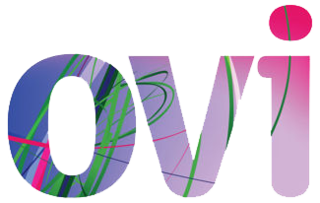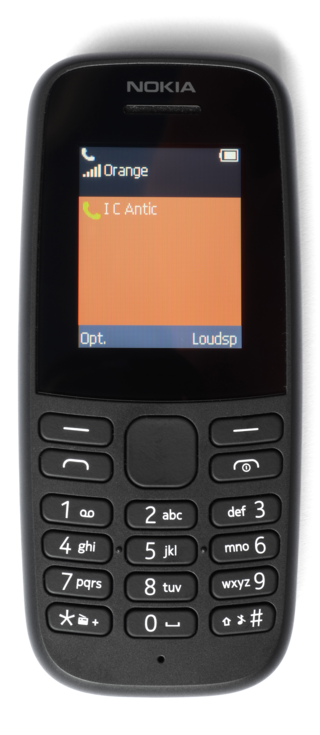Related Research Articles

Nokia Corporation is a Finnish multinational telecommunications, information technology, and consumer electronics corporation, established in 1865. Nokia's main headquarters are in Espoo, Finland, in the greater Helsinki metropolitan area, but the company's actual roots are in the Tampere region of Pirkanmaa. In 2020, Nokia employed approximately 92,000 people across over 100 countries, did business in more than 130 countries, and reported annual revenues of around €23 billion. Nokia is a public limited company listed on the Helsinki Stock Exchange and New York Stock Exchange. It is the world's 415th-largest company measured by 2016 revenues according to the Fortune Global 500, having peaked at 85th place in 2009. It is a component of the Euro Stoxx 50 stock market index.

The Nokia 3510 is a mobile phone for the GSM network, introduced by Nokia on 12 March 2002. The phone was the first Nokia phone to bring GPRS internet services to the mass market. It was also the first Nokia phone to ship with Beatnik's miniBAE engine, allowing for playback of polyphonic ringtones.

The Nokia 3310 is a discontinued GSM mobile phone announced on 1 September 2000, and released in the fourth quarter of the year, replacing the popular Nokia 3210. It sold very well, being one of the most successful phones, with 126 million units sold worldwide, and being one of Nokia's most iconic devices. The phone is still widely acclaimed and has gained a cult status due to its reputation for durability.

The Nokia 1100 is a basic GSM mobile phone produced by Nokia. Over 250 million 1100s have been sold since its launch in late 2003, making it the world's best selling phone handset and the best selling consumer electronics device in the world at the time. The model was announced on 27 August 2003 and was discontinued in September 2009.

Series 40, often shortened as S40, is a software platform and application user interface (UI) software on Nokia's broad range of mid-tier feature phones, as well as on some of the Vertu line of luxury phones. It was one of the world's most widely used mobile phone platforms and found in hundreds of millions of devices. Nokia announced on 25 January 2012 that the company has sold over 1.5 billion Series 40 devices. It was not used for smartphones, with Nokia turning first to Symbian, then in 2012–2017 to Windows Phone, and most recently Android. However, in 2012 and 2013, several Series 40 phones from the Asha line, such as the 308, 309 and 311, were advertised as "smartphones" although they do not actually support smartphone features like multitasking or a fully fledged HTML browser.

The Nokia N95 is a smartphone produced by Nokia as part of their Nseries line of portable devices. Announced in September 2006, it was released to the market in March 2007. The N95 ran S60 3rd Edition, on Symbian OS v9.2. It has a two-way sliding mechanism, which can be used to access either media playback buttons or a numeric keypad. It was first released in silver and later on in black, with limited edition quantities in gold and purple. The launch price of the N95 was around €550.

The Nokia 6300 is a mobile telephone handset produced by Nokia. It was announced on 28 November 2006 and released in January 2007. This model was assembled in several factories, including Jucu plant, near Cluj, in Romania.

Ovi by Nokia was the brand for Nokia's Internet services. The Ovi services could be used from a mobile device, computer or via the web. Nokia focused on five key service areas: Games, Maps, Media, Messaging and Music. Nokia's aim with Ovi was to include third party developers, such as operators and third-party services like Yahoo's Flickr photo site. With the announcement of Ovi Maps Player API, Nokia started to evolve their services into a platform, enabling third parties to make use of Nokia's Ovi services.

Symbian is a discontinued mobile operating system (OS) and computing platform designed for smartphones. It was originally developed as a proprietary software OS for personal digital assistants in 1998 by the Symbian Ltd. consortium. Symbian OS is a descendant of Psion's EPOC, and was released exclusively on ARM processors, although an unreleased x86 port existed. Symbian was used by many major mobile phone brands, like Samsung, Motorola, Sony Ericsson, and above all by Nokia. It was also prevalent in Japan by brands including Fujitsu, Sharp and Mitsubishi. As a pioneer that established the smartphone industry, it was the most popular smartphone OS on a worldwide average until the end of 2010, at a time when smartphones were in limited use, when it was overtaken by iOS and Android. It was notably less popular in North America.
Nokia's strategic nomenclature can be traced back in 2005 when the Nseries line was launched, offering devices with flagship specifications and premium hardware at various price points. These devices were considered the "bread and butter" of the company and were often positioned to showcase their latest technologies. Thanks to the newfound consumer and enterprise interest in smartphones at the time, the company introduced four additional collections to diversify their product portfolio and meet demands in most market segments. These new phone series were named Eseries, targeting small business and enterprise customers; Xseries, providing consumer-grade multimedia-focused devices; Cseries, which Nokia used to target both the low-end and mid-range market segments; and Tseries, for devices exclusive to the Chinese market.

Microsoft Lumia is a discontinued line of mobile devices that was originally designed and marketed by Nokia and later by Microsoft Mobile. Introduced in November 2011, the line was the result of a long-term partnership between Nokia and Microsoft—as such, Lumia smartphones run on Microsoft software, the Windows Phone operating system; and later the newer Windows 10 Mobile. The Lumia name is derived from the partitive plural form of the Finnish word lumi, meaning "snow".

Microsoft Mobile was a subsidiary of Microsoft involved in the development and manufacturing of mobile phones. Based in Espoo, Finland, it was established in 2014 following the acquisition of Nokia's Devices and Services division by Microsoft in a deal valued at €5.4 billion, which was completed in April 2014. Nokia's then-CEO, Stephen Elop, joined Microsoft as president of its Devices division following the acquisition, and the acquisition was part of Steve Ballmer's strategy to turn Microsoft into a "devices and services" company. Under a 10-year licensing agreement, Microsoft Mobile held rights to sell feature phones running the S30+ platform under the Nokia brand.

Android One is a family of third-party Android smartphones promoted by Google. In comparison to many third-party Android devices, which ship with a manufacturer's customized user interface and bundled apps, these devices run near-stock versions of Android with limited modifications, and a focus on Google services. Devices that run Android One receive OS updates for at least two years after their release, and security patches for at least three years.
Nokia 3710 is a feature phone manufactured by Nokia. It was announced by Nokia in June 2009 and released in December of that year. It was hailed as the direct successor to the Nokia 3610 fold, the previous model launched at the end of 2008.

Series 30+ is a software platform and application user interface used for Nokia-branded mobile devices. The platform was introduced by Nokia in September 2013, first appearing on the Nokia 108, and has been the main Nokia feature phone operating system after the end of the Series 30 and Series 40 platforms in 2014. Despite the similar name and user interface, S30+ is technically completely different and unrelated to S30.

The Nokia 2100 is a mobile phone announced and released in Q1 2003.

HMD Global Oy, branded as HMD and Nokia Mobile, is a Finnish mobile phone manufacturer. The company is made up of the mobile phone business that Nokia sold to Microsoft in 2014, then bought back in 2016. HMD began marketing Nokia-branded smartphones and feature phones on 1 December 2016. The company has exclusive rights to the Nokia brand for mobile phones through a licensing agreement. The HMD brand is only used for corporate purposes and does not appear in advertising, whereas the name "Nokia Mobile" is used on social media.

The Nokia 7 Plus is a Nokia-branded upper-mid-range smartphone running the Android operating system. It was announced on 25 February 2018, along with four other Nokia-branded phones.
The Nokia 2.3 is a Nokia-branded low-end smartphone launched in December 2019 running the Android operating system
References
- ↑ "Nokia 3610 - Full phone specifications". gsmarena.com. Retrieved 2015-09-06.